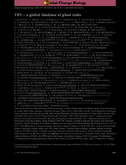Mostrar el registro sencillo del ítem
TRY – a global database of plant traits
| dc.contributor.author | Kattge, J. | |
| dc.contributor.author | Días, S. | |
| dc.contributor.author | Lavorel, S. | |
| dc.contributor.author | Prentice, I.C. | |
| dc.contributor.author | Leadley, P. | |
| dc.contributor.author | Bonisch, G | |
| dc.contributor.author | Garnier, E. | |
| dc.contributor.author | Westoby, M. | |
| dc.contributor.author | Reich, P.B. | |
| dc.contributor.author | Wright, I.J. | |
| dc.contributor.author | 125 autores más. | |
| dc.date.accessioned | 2021-02-09T05:03:23Z | |
| dc.date.available | 2021-02-09T05:03:23Z | |
| dc.date.issued | 2011-01 | |
| dc.identifier.uri | doi: 10.1111/j.1365-2486.2011.02451.x | |
| dc.identifier.uri | https://repositorio.catie.ac.cr/handle/11554/10286 | |
| dc.description.abstract | Plant traits – the morphological, anatomical, physiological, biochemical and phenological characteristics of plants and their organs – determine how primary producers respond to environmental factors, affect other trophic levels, influence ecosystem processes and services and provide a link from species richness to ecosystem functional diversity. Trait data thus represent the raw material for a wide range of research from evolutionary biology, community and functional ecology to biogeography. Here we present the global database initiative named TRY, which has united a wide range of the plant trait research community worldwide and gained an unprecedented buy-in of trait data: so far 93 trait databases have been contributed. The data repository currently contains almost three million trait entries for 69 000 out of the world’s 300 000 plant species, with a focus on 52 groups of traits characterizing the vegetative and regeneration stages of the plant life cycle, including growth, dispersal, establishment and persistence. A first data analysis shows that most plant traits are approximately log-normally distributed, with widely differing ranges of variation across traits. Most trait variation is between species (interspecific), but significant intraspecific variation is also documented, up to 40% of the overall variation. Plant functional types (PFTs), as commonly used in vegetation models, capture a substantial fraction of the observed variation – but for several traits most variation occurs within PFTs, up to 75% of the overall variation. In the context of vegetation models these traits would better be represented by state variables rather than fixed parameter values. The improved availability of plant trait data in the unified global database is expected to support a paradigm shift from species to trait-based ecology, offer new opportunities for synthetic plant trait research and enable a more realistic and empirically grounded representation of terrestrial vegetation in Earth system models. | es_ES |
| dc.language.iso | en | es_ES |
| dc.relation.ispartof | Global Change Biology, Volumen 17, (2011), páginas 2905–2935 | es_ES |
| dc.rights | info:eu-repo/semantics/openAccess | es_ES |
| dc.subject | BASES DE DATOS | es_ES |
| dc.subject | GRADIENTE | es_ES |
| dc.subject | DIVERSIDAD FUNCIONAL | es_ES |
| dc.subject | CAMBIO GLOBAL | es_ES |
| dc.subject | FACTORES AMBIENTALES | es_ES |
| dc.subject | SERVICIOS ECOSISTEMICOS | es_ES |
| dc.subject | CICLO DE VIDA | es_ES |
| dc.subject | PLANTAS | es_ES |
| dc.subject | ECOLOGIA VEGETAL | es_ES |
| dc.subject | CONSERVACION BIOLOGICA | es_ES |
| dc.title | TRY – a global database of plant traits | es_ES |
| dc.type | Artículo | es_ES |
Ficheros en el ítem
Este ítem aparece en la(s) siguiente(s) colección(ones)
-
Publicaciones y documentos [3631]


